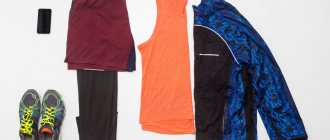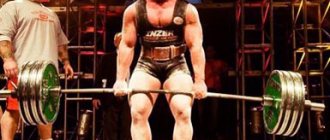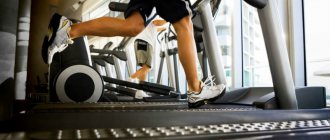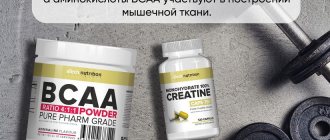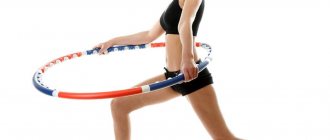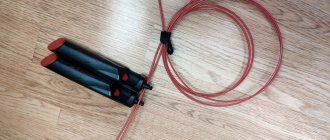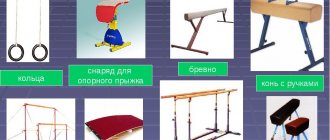A real climatic winter has arrived in Russia. And many are faced with the same question from year to year: is it worth continuing running in winter conditions?
Let’s say right away that the onset of cold weather is not at all a reason to throw your running accessories into the closet until spring. The off-season period is a very important, structure-forming period in the annual training cycle. It is at this time that the base is being prepared for the next active season and therefore it is worth adding more exercises to strengthen and stretch the muscles, focusing more on strength work, and slightly reducing the pace and volume.
If you completely stop training (read: running), then the loss of your former form will occur very quickly and then when you resume training, the risk of injury will increase. Thus, the indicator of the body’s physical readiness applicable to running is assessed by the indicator of maximum oxygen consumption (MOC). It is known that in the first two weeks without training, VO2 max decreases by 20%, then the rate decreases, but the process of VO2 decline itself lasts three months. And in order to get back into shape, it will take twice as long as it took to rest from running: if, say, an athlete hasn’t run for three months, then he will subsequently have to train for six months just to get back to his previous shape.
This is the price to pay for “downtime” during the cold season in relation to the training process and subsequent running conditions.
What to look for when choosing winter equipment?
Winter is not a reason to stop training outside. Even in cold weather, you can get just as much benefit and enjoyment from running outdoors as in the summer, as long as you choose the right equipment. Today we will tell you exactly what to look for when choosing winter running equipment.
Two main rules to remember when going to training in winter:
- dress in layers,
- choose equipment designed for temperatures at least 10 degrees higher than the thermometer shows. Within 10 minutes of starting your workout, you will be warmed up and feel much warmer.
Of course, it is worth making allowances for the climatic features of the area (high humidity or wind) and your individual heat transfer.
The difference between winter running shoes and summer ones
Running shoes for winter differ from summer ones in that the sole has a more pronounced tread pattern, but at the same time retains its softness and all types of support for the foot. And the top of the sneaker is made of a moisture-resistant, but certainly breathable membrane, under which insulation of all kinds can be located. Or it may not be located.
However, don't expect that when you put on winter running shoes, you'll feel like a duck to water on the ice. They glide almost as well as regular trekking shoes. Well, maybe a little less. For such cases, you need to look for studded models.
What's outside the window? We look at the thermometer and precipitation
Winter weather loves to present surprises: even if there is a slight minus outside, a piercing wind, freezing rain or ice can ruin your mood while jogging outside and even cause a cold. But today you can choose equipment for almost all occasions, the main thing is to know what to wear.
The easiest way to choose equipment for training in dry, clear, windless weather is:
• from 0 to -5 degrees: long-sleeved jacket (thermal underwear) and a thin windbreaker + warm tights,
• from -5 to -10 degrees: add fleece,
• below -15 degrees: we additionally insulate the bottom, combining thermal underwear with insulated tights or pants; the windbreaker should be replaced with a thicker jacket.
• At temperatures down to -5 degrees, choose light gloves, a hat, a buff and high socks; for temperatures below -10 degrees, you should give preference to insulated options: these can be mittens and a hat with a fleece lining and socks using merino wool.
When wind and precipitation increase at low temperatures, you should adhere to the same principle, but for the upper layers choose equipment using Windstopper, Softshell or Shield technologies.
Life hack: in order not to freeze even at very low temperatures, it is important to protect all exposed skin. Choose gloves with special touch areas so you don’t have to take them off when using a smartphone, and protect your facial skin, the special Repharm cream will help you with this. Remember that in winter the cream should be applied to the face at least 30 minutes before leaving the house.
Repharm Polar protection against cold and wind
Ointment to protect the skin from cold and wind. Recommended for use as a protective nourishing cream.
Let's take a closer look at what equipment options various brands offer us for each layer of clothing.
Where is the best place to run in winter?
If you are preparing for asphalt starts, of course, you should make a choice in favor of cleared tracks - better than cinder tracks, because asphalt becomes even harder when the temperature drops.
marathon and half marathon training plans and start training today!
You can also run on clean asphalt, but to do this, be sure to choose high-quality running shoes with good shock absorption.
However, clean coverage - especially in the regions - is more rare than the norm. More often you can find ice and snow drifts. If you need to run on slippery, snowy surfaces, choose trail running shoes with an aggressive tread.
And, as already mentioned, no one canceled training in the arena. Especially if you need to do speed work.
Read on the topic: 9 running surfaces and their features
Clothes: three layers
The first layer is thermal underwear, the main purpose of which is to remove moisture from the body.
Under Armor offers minimalist design and technology: the fabric has an antibacterial impregnation that prevents the appearance of unpleasant odors.
Under Armor UA Base 3.0 Crew
This UA Base 3.0 model is distinguished by a high level of heat retention, even if it’s frosty outside
Under Armor UA Base 3.0 Legging
Refers to the bottom base layer of clothing. The model features a high level of heat retention, even if it is frosty outside.
Under Armor UA Base 2.0 Crew W
Removes moisture and, due to special treatment, prevents the appearance of bacteria.
Under Armor UA Base 2.0 Legging W
The base is a material capable of retaining and retaining heat and removing moisture to the surface.
From Craft, first of all, pay attention to the Active Intensity line, which, due to its dense material and interesting design, can be used as independent clothing, and not just as a base layer.
Craft Active Intensity CN
Thanks to its dense texture and thoughtful design, the thermal jacket can be worn not only as a base layer, but also on its own.
Craft Active Intensity
Men's thermal pants for intense training in cold to moderately cold conditions.
Craft Active Intensity CN W
Thanks to its dense texture and thoughtful design, the model can be worn not only as a base layer, but also on its own.
Craft Active Intensity W
Women's thermal pants for intense training in cold to moderately cold conditions.
Also worthy of special mention are thermal underwear and underwear with Windstopper technology, which will be indispensable in difficult weather conditions.
Craft Active Extreme 2.0 Windstopper
Thermal jacket retains heat and wicks away moisture. Windstopper insert at the front for wind protection.
Craft Active Extreme 2.0 Windstopper
Thermal pants retain heat and wick away moisture. Windstopper insert at the front for wind protection.
Craft Active Extreme 2.0 Windstopper W
Thermal jacket retains heat and wicks away moisture. Windstopper insert at the front for wind protection.
Craft Active Extreme 2.0 Windstopper W
Thermal pants retain heat and wick away moisture. Windstopper insert at the front for wind protection.
If you want to pamper yourself with products from a luxury brand (for example, to give yourself a gift before the upcoming New Year), then pay attention to thermal underwear from Falke, which combines the best materials and a complex fabric structure.
Falke Maximum Warm
Thermal jacket made of two-layer knitwear, insulated from the inside. Designed for sports in cold and very cold weather.
Falke Maximum Warm W
Thermal jacket made of two-layer knitwear, insulated from the inside. Designed for sports in cold and very cold weather.
The second layer continues to wick moisture away from the body and retain heat.
As a second layer, Nike long sleeves and sweatshirts that use Terma Sphere fabric have proven themselves to be excellent: the cell-shaped structure helps to effectively wick away moisture and retain heat.
Nike Therma Sphere Element
A loose-fitting thermal jacket for running in cold weather maintains optimal body temperature, ensuring comfort over the course.
Nike Therma Sphere Element Running W
Women's thermal jacket with a zipper to the middle of the chest, cuffs with holes for thumbs, sewn mittens protect your hands from the cold.
Nike Therma Sphere Element
The model is ideal for running in cold weather, there are holes for thumbs on the cuffs, and sewn-in mittens.
The third layer primarily protects from wind and precipitation, and many brands offer new and proven models that are designed to make running in cold weather as comfortable as possible.
Nike has updated the design of the vest with Aeroloft technology: the down is now located in honeycomb cells, its location has been changed. Laser perforation will help remove excess heat if the workout has become more intense, and if you haven’t guessed right with the temperature and it’s getting really hot, the design of the vest allows you to quickly and compactly fold it and continue jogging by attaching it to your arm.
Nike Aeroloft Running Vest
A lightweight vest with goose down insulation that combines alternating insulation and ventilation zones.
Nike AeroLayer Vest W
You can combine this vest with other items of equipment depending on weather conditions, making it convenient to take with you.
Mizuno and Craft presented softshell jackets. Softshell is a multi-layer construction that combines the properties of three layers - that is, it simultaneously removes moisture, warms, protects from precipitation and is very pleasant to the touch. Clothing made from this material can replace two layers at once and is very useful in cold weather if you are not ready to restrict movement for the sake of warmth and protection from the wind.
Mizuno Static BT Softshell Hoodie
A functional jacket for running in inclement weather, with insulated chest panels and stretchy, breathable fabric on the sides.
Mizuno Static BT Softshell Hoodie W
Women's functional jacket for running in inclement weather, insulated chest panels, stretchy, breathable fabric on the sides.
Craft Sharp Softshell XC
Jacket made of three-layer softshell material for skiing and running in winter.
Craft Sharp Softshell XC W
Jacket made of three-layer softshell material for skiing and running in winter.
Why running in winter and not skiing or a treadmill?
It would seem, why torture the body and continue running training in conditions poorly suited for this? Isn't it easier to get on skis or do a workout on a treadmill?
The main advantage of running in the off-season for muscles is that in winter the tracks are slippery, so much more muscles are involved in the work than when running on regular asphalt. The muscles of the thighs, buttocks, ankle joints and ligaments with joints begin to work and become stronger much better. If you run in the snow, the thigh rises much higher, while its front surface is well trained. In the summer, to achieve a similar effect, you will have to force yourself to raise your thigh higher than usual.
There is no exercise that can replace running. Even running on a treadmill, on which a person also runs, will not be a full-fledged alternative to running. There is no impact load on the treadmill, which means that, to put it simply, it is just a special exercise where there is no natural forward movement of a person, but the track surface moves, which distorts the running process itself. Since the track moves on its own, the muscles work in a completely different way and the propelling muscles do not receive the necessary load.
When running on a treadmill, you don’t have to overcome wind resistance, and the moving belt under your feet itself sets the desired pace, which makes training much easier. Theoretically, you can even not run at all, but jump on one leg, but the simulator will still count the workout at a pace corresponding to the speed of the belt.
This won't work on the street. There you will have to do all the work yourself: pushing off the surface, resisting the wind, focusing your gaze, coping with the terrain, taking turns - a completely different process.
The University of Wisconsin conducted research into how track running differs from classic running. It has been found that there are differences between the two methods, for example in heart rate or subjective level of exertion.
When running indoors, no matter how well it is ventilated, the air will be much worse than outside, and even more so in a park or forest. Still, breathing is very important for running, and so is the amount of oxygen we get with breathing.
Running on a track can only be an alternative for runners who are recovering from injuries, as well as for situations where running in natural conditions is impossible or difficult, for example, when it is severely frosty outside. But for regular training, it is definitely better to choose running in natural conditions.
There is also another type of indoor running activity - indoor running. It will be especially relevant for athletes with a high level of training, for whom it is important to maintain high-speed conditions in the off-season and perform high-intensity work: at the PANO or MPC. The advantages of training in an arena are the presence of a fast track, comfortable temperature, and lightweight summer running equipment. However, when on an indoor treadmill, compliance with a certain unspoken etiquette is of great importance, designed to streamline the training process of a large number of people on a 200-meter circle of the arena. It is also worth remembering that due to the steep turns and the angle of the track during turns, the load on the joints and ligaments, especially the ankles, increases. Since the IAAF regulates running in a counter-clockwise direction in stadiums, it is easy to understand how the left leg in particular experiences serious impact. This can cause injuries, especially for those who have recently become acquainted with running.
We should not forget that during the winter months you can move to southern latitudes for some time. But this is not suitable for everyone - the target audience can be considered highly professional runners or those who are capable of painlessly moving to another place of residence. Particularly popular among track and field athletes is the running Mecca of our country - Kislovodsk, where, in addition to an almost year-round favorable climate and the opportunity to train at an altitude of 800-1300 meters above sea level, there is also a proper sports infrastructure.
By going to the warm south, you can maintain the quality of the training process and absorb more solar energy, accompanied by the athlete’s body receiving vitamin D naturally.
Speaking of skiing, the mechanics of movement in skiing are completely different when compared with running. Due to differences in biomechanics and the lack of impact load, over several winter months, a break in running training and replacing it with skis will cause the muscles, ligaments and joints that bear the main load during running to become unaccustomed to work. Work on skis is more static and muscles work completely differently than in running, and this will certainly have an impact in the long term. A long break in running training can lead to the fact that in the spring, when switching to running, there may be complications from the musculoskeletal system - joint pain, tendon sprains, etc.
It turns out that those muscle groups that bear the main load have the highest level of MIC: for a runner, the muscles of the lower extremities, for a skier, both the legs and arms.
During training, the skier actively works with his arms and upper shoulder girdle to push off and move forward. Moreover, the rhythm of pushing off in skiing is different from running. The skier’s movements seem to be “extended” - especially when removing the leg from the support. In running, you have to pull your leg under you and the cadence in running is 170-180 steps per minute.
the most important thing is the slope. When skiing, a person bends at the waist, and when running, the body is straight and the inclination comes from the ankle.
Thus, if you completely “switch” to skiing in winter, then when the snow melts you will practically have to learn to run again. The only way out is to not give up running. You can combine skiing with running to increase your overall endurance and diversify your training, but the main load should be focused on running.
Head, neck and hands - keep warm
The choice of hats and buffs is large, and from all this variety it is worth highlighting the Polar series buffs from Buff with a fleece lining, which will be especially relevant in cold weather:
Buff Polar
Buff Polar Neckwarmer
and the Brilliant 2.0 series from Craft with reflective print:
Craft Brilliant 2.0
A warm and functional hat with reflective print, perfect for running in cold weather.
Craft Brilliant 2.0 Thermal
Comfortable gloves with an ergonomic cut, designed for running in cold weather.
For harsher weather conditions, consider gear from Under Armor and Craft using Windstopper:
Under Armor Windstopper Beanie 2.0
Hat made of double jersey with protection from rain and wind. Warm fleece interior, technical fabric exterior with water-repellent UA Storm finish.
Under Armor UA Storm Windstopper Gaiter
The buff is made of double dense knitwear, has water-repellent properties and protects from wind.
Craft Power XC Windstopper
There is a windproof membrane on the wrists, insulation inside, and wear-resistant leather on the palms.
Craft Active Extreme 2.0 Windstopper
Flat seams, good thermoregulation, front membrane for protection from wind.
Cold Weather Socks
In cold weather, it is wiser to give preference to thicker and higher models of socks that will retain heat in the ankle area. It is worth paying attention to models with the addition of wool:
ASICS Winter Running Sock
Winter socks. Arch support. 21% merino wool. The socks are divided into right and left.
Moretan Run Merino
Socks made from natural merino wool, which protects against extremely low temperatures, are designed for winter running and daily wear.
Falke RU4 Wool
Warm socks with the addition of merino wool have excellent thermoregulation and maintain a comfortable temperature.
If your shoes have a Gore-Tex membrane, you should choose socks that are recommended for use with such shoes.
X-Bionic Speed One
Socks for running. Reduces shock load. Anatomical structure for the right and left leg.
